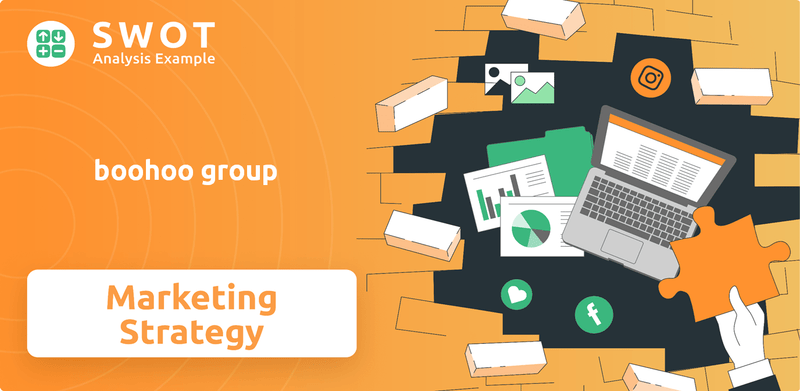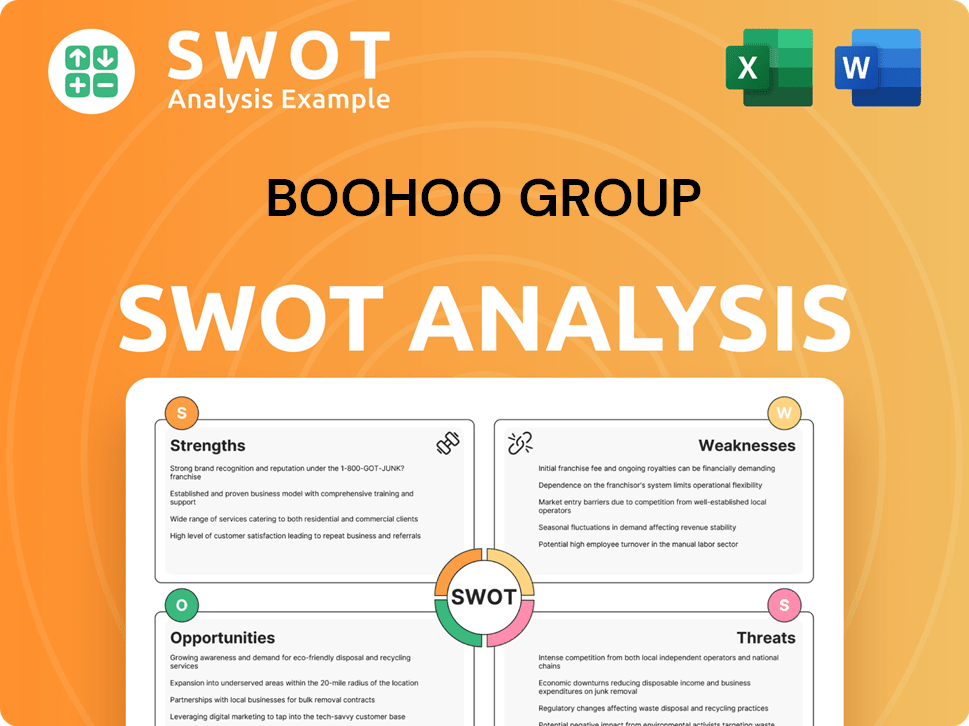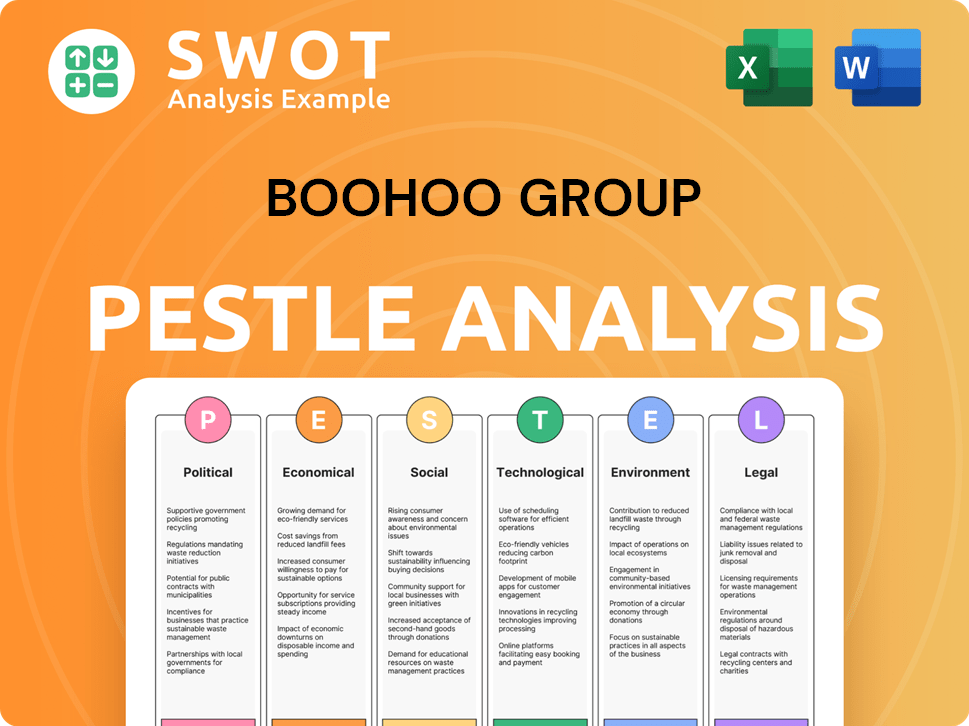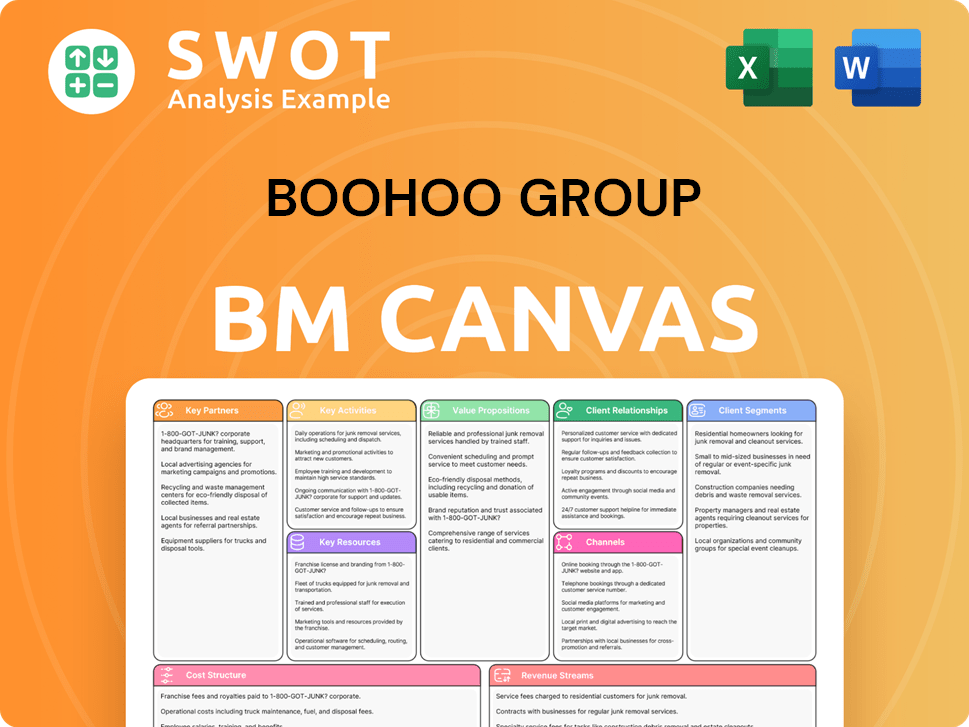boohoo group Bundle
Can Boohoo Group's Sales and Marketing Strategies Revitalize its Performance?
In the fast-paced world of e-commerce fashion, Boohoo Group has consistently adapted its approach. This analysis delves into the core of Boohoo's operations, examining its evolving sales and marketing strategies. From its origins in ultra-fast fashion to its strategic pivot towards a marketplace model, we uncover the key decisions shaping Boohoo's trajectory.

This exploration of the boohoo group SWOT Analysis will dissect Boohoo's innovative sales and marketing tactics, including its digital marketing strategy and customer acquisition strategies. We'll also analyze its brand positioning and promotional activities within the competitive online retail landscape. Understanding Boohoo's approach to its target audience and how it navigates the fast fashion market will be crucial.
How Does boohoo group Reach Its Customers?
The Growth Strategy of boohoo group heavily relies on online sales channels to reach its global customer base. The company's primary sales strategy centers around its e-commerce platforms, which include websites for its various brands like boohoo, boohooMAN, and PrettyLittleThing. This exclusive online model allows for broad market reach and operational efficiencies, forming the core of its sales and marketing efforts.
A significant element of the boohoo sales strategy involves the evolution towards a marketplace model. This is particularly evident with the acquisition of Debenhams in 2021, which was transformed into a digital marketplace. This shift to a capital-light, low-risk operating model has proven successful, with Debenhams' GMV growing significantly.
The boohoo marketing strategy also encompasses strategic shifts in distribution. In September 2024, the company altered its US operations, moving away from its Pennsylvania distribution center. All US orders are now fulfilled from its UK distribution center in Sheffield. Additionally, the company is exploring new market routes through partnerships, such as the launch of Nasty Gal in Nordstrom stores, and is in advanced talks for similar collaborations with major US brands. This move towards wholesale and marketplace models is aimed at driving growth in new markets.
The foundation of the boohoo sales strategy is its e-commerce platforms. These include dedicated websites for each brand, offering a wide range of products. This online-only approach allows for broad reach and efficient operations, critical for fast fashion.
The marketplace model, particularly with Debenhams, is a key element of the boohoo group business model. Debenhams' GMV grew by 33.8% to £654 million in FY2024/25. Over 3,500 brands were onboarded by February 2024, demonstrating the success of this model.
In September 2024, boohoo adjusted its US operations, centralizing fulfillment from the UK. This change followed a successful trial. The company is also exploring new routes to market through partnerships and wholesale models.
Partnerships are becoming increasingly important for boohoo. The launch of Nasty Gal in Nordstrom stores is a prime example of the boohoo marketing strategy in action. The group is in advanced talks for similar collaborations.
The boohoo group's sales strategy is primarily digital, focusing on its own e-commerce sites and a growing marketplace presence. This approach allows the company to reach a global audience efficiently. Strategic partnerships and distribution adjustments support this digital-first approach.
- E-commerce Websites: Core sales through boohoo, boohooMAN, and other brand websites.
- Marketplace Expansion: Leveraging the Debenhams model to other brands for growth.
- Strategic Partnerships: Collaborations like Nasty Gal in Nordstrom stores to expand reach.
- Distribution Optimization: Centralizing US fulfillment from the UK to improve efficiency.
boohoo group SWOT Analysis
- Complete SWOT Breakdown
- Fully Customizable
- Editable in Excel & Word
- Professional Formatting
- Investor-Ready Format

What Marketing Tactics Does boohoo group Use?
The Growth Strategy of boohoo group hinges on a dynamic marketing approach, particularly within the digital sphere. The company utilizes a blend of tactics to boost brand recognition, draw in potential customers, and ultimately, drive sales. A strong emphasis is placed on digital channels, influencer collaborations, and data-driven marketing to stay ahead in the competitive e-commerce fashion market.
Influencer marketing and social media engagement are vital to the
The company's marketing strategy frequently incorporates sales promotions and discounts to drive conversions. These are key elements of the
Collaborates with a diverse range of influencers, from micro-influencers to major celebrities, to generate buzz and promote exclusive collections. This approach helps expand its reach and connect with various customer segments.
Maintains a strong presence across platforms like Instagram, TikTok, Snapchat, and Facebook. These platforms are used to showcase collections, interact with customers, and run interactive campaigns.
Leverages UGC by reposting content from influencers and customers. This tactic helps foster a sense of community and turns customers into brand advocates, enhancing brand loyalty.
Utilizes platforms like Bloomreach for AI-powered search and merchandising. This allows for personalization across marketing campaigns and on-site experiences, improving customer engagement.
Launched 'The Boohoo Collective' in the UK, expanding to the US in August 2024, allowing thousands of creators to curate personal storefronts. This initiative highlights the brand's investment in social commerce.
Frequently incorporates sales promotions and discounts to drive conversions. These offers are a key component of the
The
- Influencer Marketing: Collaborations with a wide range of influencers to create buzz and promote collections.
- Social Media Engagement: Active presence on platforms like Instagram, TikTok, and Facebook to showcase collections and interact with customers.
- User-Generated Content (UGC): Reposting content from influencers and customers to build community and brand advocacy.
- Data-Driven Marketing: Utilizing platforms like Bloomreach for AI-powered search and merchandising to personalize the customer experience.
- The Boohoo Collective: A social commerce initiative allowing creators to curate storefronts and earn commissions.
- Sales Promotions: Implementing discounts and promotions to drive conversions and boost sales.
boohoo group PESTLE Analysis
- Covers All 6 PESTLE Categories
- No Research Needed – Save Hours of Work
- Built by Experts, Trusted by Consultants
- Instant Download, Ready to Use
- 100% Editable, Fully Customizable

How Is boohoo group Positioned in the Market?
The boohoo group positions itself as a leading e-commerce fashion retailer, focusing on trend-led fashion at affordable prices. Its core target demographic is the 16-to-40-year-old age group. The company’s brand identity is built upon its fast fashion business model, rapidly translating catwalk trends and celebrity styles into accessible products.
The group’s key message centers around providing up-to-date and inspirational fashion 24/7. It differentiates itself through a diverse brand portfolio, including labels like Boohoo, BoohooMAN, PrettyLittleThing, Karen Millen, and Debenhams. This strategy allows the group to appeal to a broad customer base, from youth-focused labels to more premium and mature demographics, enhancing its overall market presence.
In March 2025, the rebranding to Debenhams Group was a strategic move to leverage the Debenhams brand's heritage and its successful marketplace model. This pivot aimed to capitalize on stronger brand recognition and perceived value among consumers. This also addresses past reputational issues associated with the Boohoo name concerning sustainability and quality.
The primary target audience for the boohoo group is the 16-to-40-year-old demographic. This group is actively engaged with online retail and fast fashion trends.
The boohoo group utilizes a multi-brand strategy to cater to diverse customer segments. This includes youth-focused brands and premium labels, expanding its market reach. The Karen Millen brand, for example, has been revitalized as a digital-first, premium brand.
In November 2024, the group introduced a new logo and monochrome branding with blush, concrete, and chrome elements. This refresh aimed for a 'young, fresh and confident' aesthetic, aligning with its core customer base.
The group maintains brand consistency across its online channels, with a strong focus on engaging with its target audience on social media platforms like Instagram and TikTok. This is a key element of its boohoo marketing strategy.
As of March 10, 2025, Debenhams, as part of the group, held a 1.4 buzz score and a 13.6 consideration score, in contrast to Boohoo's -1.5 buzz score and 3.5 consideration score. This data highlights the strategic importance of the Debenhams brand in improving the overall group perception.
- The Debenhams brand contributes positively to the group's brand image.
- The rebranding strategy aims to leverage Debenhams' stronger brand recognition.
- The move is designed to address past reputational challenges.
- This shift supports the boohoo group's growth strategy.
boohoo group Business Model Canvas
- Complete 9-Block Business Model Canvas
- Effortlessly Communicate Your Business Strategy
- Investor-Ready BMC Format
- 100% Editable and Customizable
- Clear and Structured Layout

What Are boohoo group’s Most Notable Campaigns?
The boohoo group heavily relies on digital campaigns for its sales and marketing strategy, particularly those involving influencers and social media. The company's approach emphasizes continuous engagement and collaboration to stay relevant in the fast fashion industry. This strategy is designed to build brand awareness and drive sales growth within the competitive e-commerce fashion market.
A key aspect of the boohoo group marketing plan involves leveraging influencers and celebrities to amplify its reach. These collaborations are seen as crucial for building brand credibility and driving customer engagement. The boohoo group's advertising campaigns are often centered around creating buzz and generating conversation, which is essential for maintaining a strong online retail presence.
The company's digital marketing strategy focuses on adapting to trends and consumer behavior. By using social media strategy effectively, boohoo aims to boost customer acquisition strategies. The boohoo group's business model is built on a foundation of adapting to market trends and consumer preferences.
Launched in the UK and expanded to the US in August 2024, 'The Boohoo Collective' is a key initiative. It integrates thousands of creators into the shopping experience through personal storefronts on Boohoo.com. The objective is to boost social traffic and enhance the influencer marketing strategy.
In November 2024, the company launched the international partywear campaign 'People will talk...'. This campaign is part of a broader brand refresh project. The campaign aims to reintroduce a revamped visual identity, including a new logo and color palette.
The company frequently collaborates with influencers and celebrities. Past successful collaborations, such as those with Paris Hilton and Kourtney Kardashian, have generated significant buzz. These collaborations are a cornerstone of the boohoo group marketing strategy.
The key objectives of the campaigns are to generate conversation and align the brand with its desired perception. The company aims to build brand awareness, credibility, and engagement, ultimately leading to sales. This approach is vital for boohoo group market share growth.
boohoo group Porter's Five Forces Analysis
- Covers All 5 Competitive Forces in Detail
- Structured for Consultants, Students, and Founders
- 100% Editable in Microsoft Word & Excel
- Instant Digital Download – Use Immediately
- Compatible with Mac & PC – Fully Unlocked

Related Blogs
- What are Mission Vision & Core Values of boohoo group Company?
- What is Competitive Landscape of boohoo group Company?
- What is Growth Strategy and Future Prospects of boohoo group Company?
- How Does boohoo group Company Work?
- What is Brief History of boohoo group Company?
- Who Owns boohoo group Company?
- What is Customer Demographics and Target Market of boohoo group Company?
Disclaimer
All information, articles, and product details provided on this website are for general informational and educational purposes only. We do not claim any ownership over, nor do we intend to infringe upon, any trademarks, copyrights, logos, brand names, or other intellectual property mentioned or depicted on this site. Such intellectual property remains the property of its respective owners, and any references here are made solely for identification or informational purposes, without implying any affiliation, endorsement, or partnership.
We make no representations or warranties, express or implied, regarding the accuracy, completeness, or suitability of any content or products presented. Nothing on this website should be construed as legal, tax, investment, financial, medical, or other professional advice. In addition, no part of this site—including articles or product references—constitutes a solicitation, recommendation, endorsement, advertisement, or offer to buy or sell any securities, franchises, or other financial instruments, particularly in jurisdictions where such activity would be unlawful.
All content is of a general nature and may not address the specific circumstances of any individual or entity. It is not a substitute for professional advice or services. Any actions you take based on the information provided here are strictly at your own risk. You accept full responsibility for any decisions or outcomes arising from your use of this website and agree to release us from any liability in connection with your use of, or reliance upon, the content or products found herein.